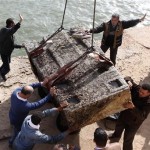 Egyptian authorities lifted a nine-ton block of red granite thought to have been part of a pillar of the Temple of Isis in Alexandria out of the sea today.
Egyptian authorities lifted a nine-ton block of red granite thought to have been part of a pillar of the Temple of Isis in Alexandria out of the sea today.
The temple was part of a large Pharaonic palace complex from the Ptolemaic dynasty. It was in this sea-side palace that Cleopatra trysted with Marc Anthony, although the pylon most likely predates Cleopatra herself.
The block is the first major artefact extracted from the harbour since 2002, when authorities banned further removal of major objects from the sea for fear it would damage them.
It was discovered by a Greek expedition in 1998.
To retrieve it, divers had to spend weeks cleaning it of mud and scum before dragging it across the sea floor for three days to bring it closer to the harbour’s edge.
The plan is to keep it in a freshwater tank for 6 months to dissolve all the sea salt. It helps pickle artifacts when they’re underwater, but once they’re dredged up, the salt becomes a corrosive. Once the conservation process is over, the Isis pylon will be housed in a temporary downtown museum along with 200 other objects raised from the harbor over the past couple of decades.
In the long term, the plans are far more ambitious. It’s still in the planning stages, but Egypt and UNESCO are collaborating to create an underwater museum complete with tunnels that would allow to visitors to explore the ruins of the old city, felled by earthquakes in the 4th century.
Marine archaeologists have already found 6,000 artifacts under the harbor in Alexandria, including dozens of sphinxes and pieces of what they think is the famous Pharos, the lighthouse that was one of the seven wonders of the ancient world.
The underwater museum would also have an above ground building, which is where the Isis pylon would be displayed permanently. Mind you, nobody’s even sure this is strictly feasible. Not only is the projected cost a challenging $140 million which neither Egypt nor UNESCO actually has right at the mo, but the technical obstacles of building an underwater museum in a harbor known for ship-destroying storms and city-destroying earthquakes will be hard to surmount.